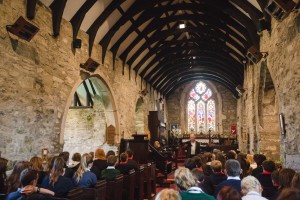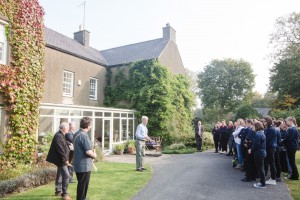
September 29, 2014, by mjroyer
Seashells, pirates and Mr William Bulkeley’s Diaries
William Bulkeley day
On the 19th and 20th of September, we had the privilege of being asked to participate in the events surrounding the launch of the online digital versions of the diaries of Mr William Bulkeley (held at Bangor University Archives). The diaries represent an important source on the social history of Anglesey during the 18th century, but also contain daily observations on the weather. Events included a dramatization of the diaries played by actors of the ‘Cwmni Pendraw’ troupe, written and directed by Wyn Bowen Harries, who also played Mr Bulkeley himself. Music from the period, written by Stephen Rees and performed on traditional instruments, accompanied the play. After the performance, we presented a talk about research on historical weather and climate by the Climate Change Consortium of Wales (C3W). Vince (C3W outreach officer) produced a short film of the event which is now available online http://vimeo.com/107412330 .
Bulkeley’s diaries
Mr Bulkeley lived in Brynddu, Llanfechell on the isle of Anglesey, north Wales, from 1691 to 1760 and his diaries cover the years 1734 to 1760 (unfortunately the one covering 1743-7 is missing). According to the stories, he started writing them after he became a widower as a way to pass the time. And pass the time he did; he described the weather and social customs of the time at great length. It is said that not a day went by without Mr Bulkeley faithfully recording which way the wind blew. He also wrote about the markets and fairs, the size of the village, wages, football and his work as squire of Llanfechell and Anglesey Justice of the Peace. However Mr Bulkeley’s life was anything but ordinary to quote Wyn Bowen Harries: “William Buckeley’s life reads like a soap opera. His daughter married a pirate, his son died of alcoholism and his mother died falling under a ladder before being trampled by cattle.” (BBC, 21 September 2014).
Seashells and historical weather
On Friday (for local school children) and Saturday (for the general public), the events started at Mr Bulkeley’s house in Brynddu, which is to this day owned by one of his descendants, with a play based on the events described in his diaries. The actors and musicians then led the audience across a field towards Llanfechell church on a path that was taken regularly by Mr Bulkeley himself. In town the play resumed in Llanfechell Church which was built in the 12th century and still looks a lot like it did at the time of Mr Bulkeley. Once the performance was over it was off to Libanus Chapel across the road for our presentation on using proxy data including diaries, tree rings and seashells to reconstruct past weather. In the audience was James Scourse, Director of C3W and a specialist in sclerochronology (the science behind the use of seashells in climate reconstructions) who was nice enough to bring samples to pass about to the great delight of students and adults alike.

The dramatization of the diaries by Wyn Bowen Harries and Cwmni Pendraw was performed in Llanfechell Church (c) Vince Jones/C3W
Mr Bulkeley’s diaries are one of our most important sources in identifying past weather events as they are relatively early, and cover an interesting period of quite variable conditions in the 18th century. 1740 is regarded as the coldest winter on record and it occurred after a period of relative warmth during the 1730s (Jones and Briffa, 2006). The consistent way Mr Bulkeley recorded the daily weather in his diaries and the fact that he rarely travelled means that we have a reliable and continuous record. Their transcription by Sue Walton, (commissioned by Llen Natur), which is freely available on the web, makes our job much easier. Looking at past weather through diaries is a complex undertaking but very rewarding as it allows you to put that event into a context. Not only do we find out about what the weather was but depending on the writer, we can also find out how people perceived that event, what effects it had on the local area and what responses were put in place. Combining various proxy data then allows us to reinforce our knowledge of weather events and the social responses surrounding them. However a question that often comes up with people working with written archives is what will be the archives of the future, who will replace Mr Bulkeley?
Marie-Jeanne, Sarah and Cerys.


Sounds like a great event – so good to see these important records receiving attention and coverage and also to see collaboration between colleagues at Aberystwyth, C3W and Llen Natur. The film is a good watch- to be recommended (and it looks like the weather was fine for the whole event!)